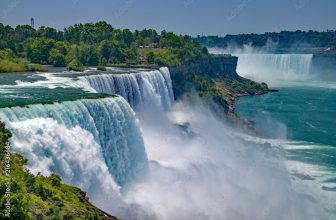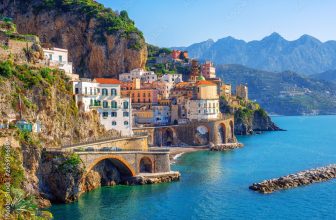When traveling to Santorini, make sure to explore the island’s main towns: Fira and Oia. These picturesque towns are situated above a caldera that was destroyed by a volcanic eruption in the sixteenth century BC. The towns of Santorini offer stunning views of the sea and small islands to the west. The volcanic pebbled beaches are famous throughout Greece, and you can walk along them to enjoy the spectacular views.
Oia
If you’re planning a holiday to the Greek Aegean island of Santorini, then don’t miss the quaint coastal town of Oia. The charming white-washed houses in this town overlook a water-filled caldera. Visit the Naval Maritime Museum, housed in a 19th-century mansion, for information about seafaring history. And don’t miss the Oia Castle, for sunset views.
From the Fira airport, you can take a cab or a private transfer to Oia. Public buses connect many towns on the island. A taxi is the most convenient option, but you might want to consider walking. Bring plenty of water and avoid wearing heels. While Oia is the most popular place to stay, it’s also the most expensive. Make sure you book your accommodation in advance so you can enjoy the sunset at the end of the day.
The Oia Marriott Resort offers a rooftop pool and five outdoor pools, along with an extensive spa. Rooms at this hotel are spacious, and some feature outdoor jacuzzis. A variety of suites offer caldera views, while more lavish villas include a kitchenette and a private outdoor hot tub. There’s also a caviar and oyster restaurant, and the entire hotel can be rented as a 10 bedroom villa for an extended stay.
Fira
Explore the cliff-top town of Fira in Santorini, the capital of the Greek island in the Aegean Sea. The museum of prehistoric Thira displays items from Bronze Age settlements, including ceramics and wall paintings. The Orthodox Metropolitan Cathedral displays frescoes by local artist. Fira’s clifftop location affords views of the sea and Nea Kameni.
The town of Fira is home to the Orthodox Metropolitan Cathedral, which was built in 1827. Inside, you’ll find magnificent frescoes, ornate décor, and stunning views of the caldera. There are also numerous shops and cafés, and you can enjoy a delicious Greek meal at one of the many restaurants and cafes located throughout Fira. You can also tour the quaint, old town while taking in the beautiful views.
At the turn of the century, Fira became Santorini’s new capital. The Ottoman Turks had removed the threat of pirates and allowed the island to develop as a tourist destination. The town’s climate is Mediterranean, with warm, dry summers and mild winters. The coldest months are January and February, but strong winds blow throughout the island. Fira is the most popular destination for cruise ship passengers.
Metaxi Mas
Located in Exo Gonia, Metaxy mas is a traditional Greek tavern that promises to serve great Greek food. The menu features local recipes from Santorini as well as dishes from other regions of Greece. The food is served in generous portions, and all the ingredients are fresh and in season. It’s definitely worth the visit. If you’re visiting Santorini, be sure to make time to eat at Metaxy mas.
Located in the small village of Exo Gonia, Metaxi Mas is an ideal place to go for traditional Greek food. The menu is diverse, and many dishes are Cretan, as well as Mediterranean. Among the most delicious dishes are kadaifi, which are stuffed with cheese and berry compote. There are plenty of vegetarian options on the menu, too. A delicious evening at Metaxi Mas is guaranteed to leave you with a happy belly and a feeling of contentment.
You can use GPS to find the Metaxi Mas and other places in Santorini by using the words “Metaxi mas”. There are plenty of other places to eat in Santorini, including the famous Taverna Diagoni and the traditional “Opa.”
Caldera trail
Taking the Caldera trail on Santorini will allow you to see the island’s volcanic crater, and you’ll also have an opportunity to explore the village of Imerovigli, which is often called the balcony to the Aegean. This village sits at the highest point of the caldera and provides a beautiful view of the surrounding area. Locals used to climb up the hill to watch for pirate ships. It’s a beautiful hike, and the golden afternoon light paints the volcanic rocks in a gorgeous way.
There are two ways to hike the Caldera trail on Santorini. You can start by hiking from Fira, or walk from Oia to Fira. Both paths are scenic, but the caldera side is a little more challenging due to loose gravel. Regardless of how advanced you are, both routes have spectacular views. It’s recommended to wear shoes that don’t have too much tread.
Hikers who have some fitness can start the hike by taking the Fira-Oia route. This six-mile trail will take you through four villages and the volcanic caldera. You’ll also find beautiful vistas as you hike, so make sure to bring your camera! The Caldera trail on Santorini will provide you with incredible views. You’ll enjoy the hike as well as the view of the Aegean sea.
Minoan ash
The eruption of the volcano Thera in 1613 BC buried a Minoan settlement on Santorini. This pyroclastic deposit is the best-documented one to date. Although it is relatively young, it has been observed as far away as Istanbul, Turkey and Egypt. Santorini is an island of volcanic origin, and the eruption is the earliest known in the Aegean Sea.
This eruption may have had a global impact as it destroyed much of the Minoan civilization. Its impact was so extensive and widespread that it changed the political landscape of the ancient world. Scientists believe that it caused multiple tsunamis that hit Crete, about a hundred miles away. As such, the ash of the eruption could have spread beyond the Greek mainland and have impacted cities as far as China and North America. Although the causes of the eruption are not clear, many people believe that it played a role in the legend of Atlantis, the Biblical plagues, and the exodus from Egypt.
The ash from the eruption of Santorini is now buried deep in the soil, revealing ancient houses and a stone bath. Archaeologists believe that the ash from the eruption was part of the Minoan civilization. Ancient writers believe that the ash cloud caused by the Thira eruption circled the Earth for two years, plunging it into a period of global cooling.
Cycladic architecture
The whitewashed villages, blue-domed churches, and cobbled streets of Santorini are all examples of Cycladic architecture. These buildings differ from other Greek islands because they were shaped by the landscape rather than by a style. The volcanic landscape also influenced the architecture of the island. The combination of white and blue is quite striking. The unique combination of shapes and materials created a unique style of architecture.
The dominant colors of Cycladic architecture include blue and white. These colors are representative of the Greek flag and are in harmony with the bright blue of the sea and the sky. Typically, Cycladic houses are made of stone, and were left unpainted for centuries. Then, the island’s inhabitants began to use different paint colors, which made them stand out among the surrounding landscape. Yellow ochre, earth red, and black were popular colors for Cycladic houses until the 1930s.
In addition to Cycladic architecture, there are other elements of this style of architecture that define it. Its characteristic flat roofs and cubic shapes are unique to each island. It also features whitewashed walls that reflect the Mediterranean sun. Cycladic architecture has influenced many famous modern architects, including Le Corbusier and Iannis Xenakis, who used it as an inspiration for his own holiday home.
Atlantis legend
There are a number of different theories about the origin of the Atlantis legend on Santorini. Many people believe that the island was once a powerful, advanced civilization that sank into the sea around 9,600 B.C. However, the archaeological site that has triggered this legend is not on Santorini. Thousands of historians have tried to trace this mythical island and its legends to its place of origin, but none have succeeded.
Ancient ruins of the city of Akrotiri are still extant today, and new discoveries indicate that it was over 3,000 years old. The Greek philosopher Plato wrote of an advanced civilization that was wiped out by the gods. Scientists and archaeologists have found paintings that show a society that resembles that of Plato. These paintings are also very vivid, and depict an idyllic paradise.
According to Plato’s “Dialogues,” Atlantis was an island in the Atlantic Ocean beyond the Pillars of Hercules. Its inhabitants had advanced culture and civilization, and their society was founded on a divine king, Atlas. They conquered many other places, including Africa and Europe, but were ultimately wiped out by an Athenian-led alliance. Today, this legend is a popular tourist attraction on Santorini.







